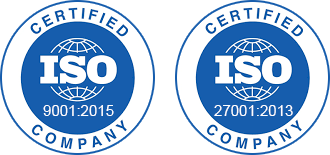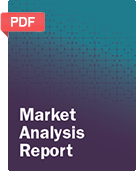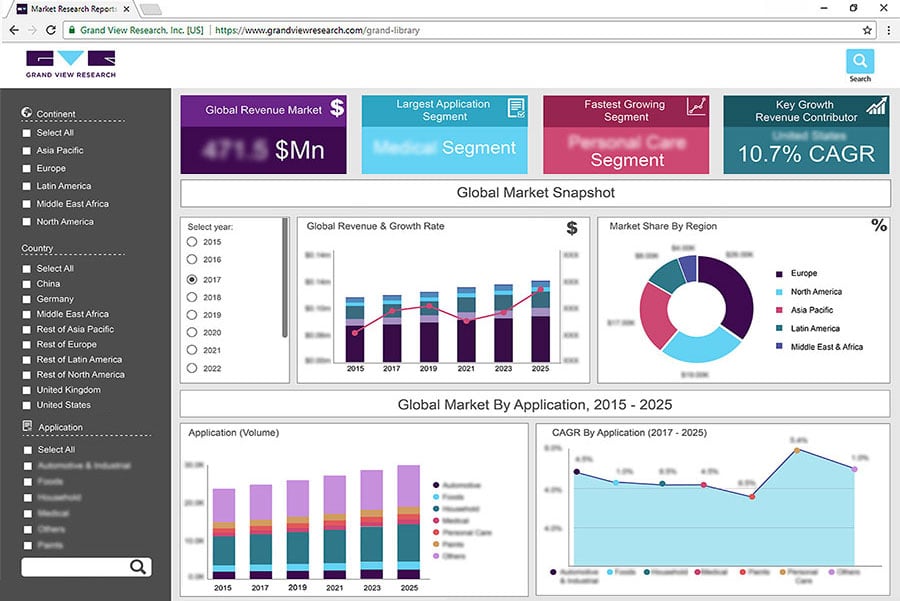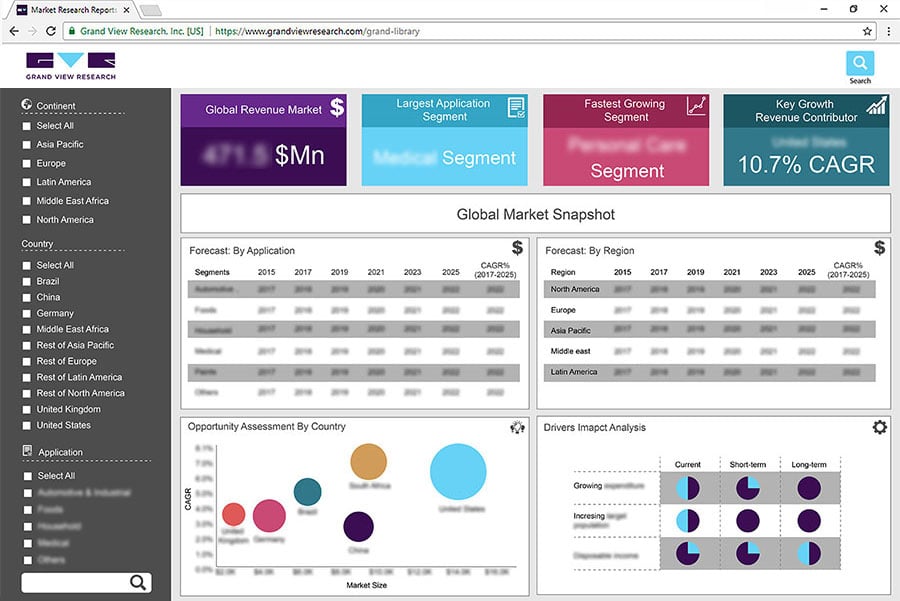- Home
- »
- Animal Health
- »
-
Companion Animal Medicine Market Size & Share Report,2030GVR Report cover
![Companion Animal Medicine Market Size, Share & Trends Report]()
Companion Animal Medicine Market Size, Share & Trends Analysis Report By Animal Type (Dogs, Cats, Horses, Other Companion Animals), By Region (North America, Europe, Asia Pacific, Latin America, Middle East & Africa), And Segment Forecasts, 2023 - 2030
- Report ID: GVR-4-68039-698-0
- Number of Report Pages: 150
- Format: PDF, Horizon Databook
- Historical Range: 2018 - 2021
- Forecast Period: 2023 - 2030
- Industry: Healthcare
Report Overview
The global companion animal medicine market size was valued at USD 19.5 billion in 2022 and it is expected to expand at a compound annual growth rate (CAGR) of 9.9% from 2023 to 2030. The increasing prevalence of diseases in pets, rising pet expenditure, humanization of pets, adoption of online channels for buying pet medicines, and initiatives by key companies are the main factors fueling the market growth.
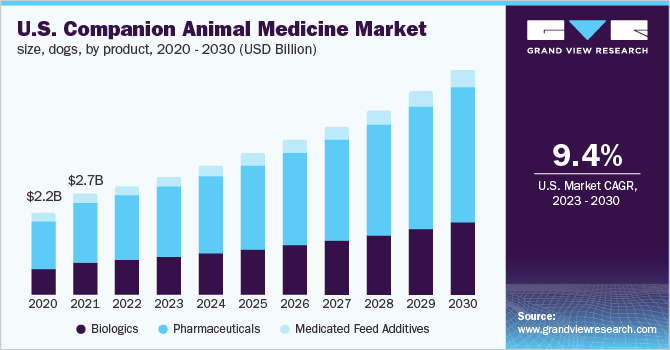
According to a 2021 article in the BMC Veterinary Research Journal, the prevalence of dental disorders diagnosed in dogs in the U.K. was found to be 14.10% and skin disorders were found to be 12.6%. The increasing number of veterinary visits and rising adoption of pet insurance are boosting market growth. For instance, Trupanion, a pet insurance company, announced that pet insurance enrollments increased to 1.3 million as of June 2022. It observed 32% growth in the second quarter of 2021.
The COVID-19 outbreak notably impacted the market. Some of the adverse effects included low demand, supply chain disruptions, hurdles in research activities, and dampened sales. For instance, Elanco’s revenue dipped by 10.0% during the first quarter of 2020, mainly due to working capital pressures and reduced demand. Merck reported a USD 100 million negative impact of the pandemic on its animal health division revenue during Q2 2020.
Despite the COVID-19 outbreak, some companies reported positive or no impact on their financial performance. Calier, for instance, reported a positive year for its companion animal segment. The company even launched an external parasiticide for dogs, cats, and ferrets- Dynacan Spot-On. Vetoquinol’s veterinary drugs and nonmedical products lineup contributed to an overall increase in 2020 sales. However, using remote support platforms and e-commerce sales channels has helped the market reach its full potential with an increased growth rate in 2021.
In addition, the American Veterinary Medical Association(AVMA) reported a fall in vet visits during the initial period of the COVID-19 outbreak. However, the vet visits and practice revenues recovered during the latter half of 2020 and into 2021. AVMA reported year-on-year growth of 14.9% and 5.1% in practice revenues and patient visits during November 2020, respectively. The AVMA estimated that revenue and visits increased on average by 13.3% and 5.1% Y-o-Y respectively from November 2020 to 2021.
Pet ownership also continued to increase in several key markets owing to mental health benefits and many people working from home. Deutsche Welle (DW) for instance, reported a surge in demand for dogs and cats in Germany during 2020. About 20% more pet dogs were purchased during 2020 in comparison to previous years according to the German Kennel Club (VDH).
The upcoming patent expiry dates of certain key companion animal drugs and formulations and R&D initiatives by market players are other factors expected to contribute to market growth. According to the European Group for Generic Veterinary Products (EGGVP), the availability and use of generic veterinary medicines are on the rise. According to the 2021 annual report of Zoetis, all patents held for Revolution, Revolution Plus, and Stronghold containing selamectin as an active ingredient expired in key markets in 2019.
The generic versions of selamectin (the active ingredient in all 3 products) are now available in markets including Europe, North America, and Australia. Other players are leveraging similar opportunities brought by patent expiry. Norbrook’s product model, for example, involves using molecules already established in the market. Its R&D strategy is based on being the first generic to market wherever possible by providing a balanced lineup of veterinary pharmaceutical products.
Animal Type Insights
The dogs segment dominated the market and accounted for the largest revenue share of nearly 45% in 2022. On the other hand, the cats segment is anticipated to witness a lucrative CAGR of 10.3% in the coming years. This is owing to the high popularity of dogs and cats as pets, the rising prevalence of canine/feline diseases, and the availability of numerous medicines for pets.
According to the American Pet Products Association (APPA)’s survey of 2021-2022, dogs and cats are the most popular pets in the U.S. with 69 million households owning dogs and 45.3 million households owning cats. The rising trend of the humanization of pets in the country and the premiumization of pet products has led to increased expenditure on pet health, medicines, and treatment. Pet parents in the U.S. were estimated to have spent USD 123.6 billion in 2021.
By product, the pharmaceuticals segment dominated the market and accounted for a revenue share of over 59% in 2022. This is due to the availability of a large number of companion animal pharmaceuticals and the rising demand for parasiticides and other products for commonly occurring infections in pets. For instance, as per the Companion Animal Parasite Council (CAPC), the highest percent increase in Lyme disease and heartworm infections along with anaplasmosis and ehrlichiosis was widely reported among U.S. pets in 2022.
The biologics segment, on the other hand, is expected to grow the fastest. By dog indication, the canine distemper segment accounted for the largest revenue share of over 31% in 2022. The disease is potentially lethal and highly contagious. Increased awareness amongst pet owners and the availability of various treatment options are the key contributing factors to the segment's largest market share.
Distribution Channel Insights
By distribution channel, the hospital pharmacy segment held the largest revenue share of about 48% in 2022. The large share of the segment can be attributed to pet parents opting for veterinary hospitals for the treatment of their pets thus making hospital pharmacies primary centers for buying the prescribed medications.
The e-commerce segment is projected to grow at the fastest CAGR of over 14% during the forecast period. Drivers contributing to this growth include the growing number of e-commerce websites selling pet medicines and the ease of buying online leading to a shift in consumer behavior.
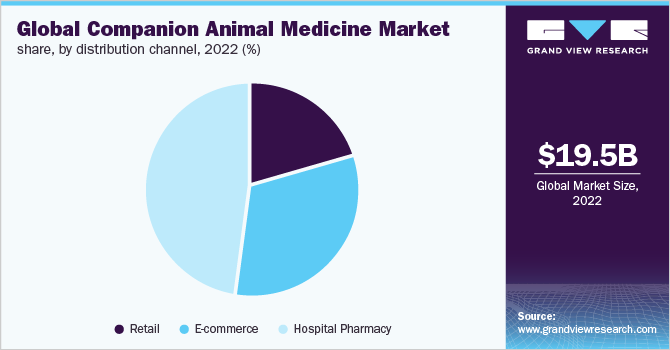
Walmart for instance provides prescription delivery service for pet medicines through its online channel walmartpetrx.com. Cornell University Hospital for Animals (CUHA) Pharmacy, on the other hand, supplies both human and animal health products. The CUHA on-site pharmacy also provides shipping at extra cost and refill services. According to the American Animal Hospital Association (AAHA), e-commerce is becoming an integral part of pet-related businesses.
Regional Insights
In 2022, North America held the largest revenue share at about 36%. This was owing to initiatives by the government and private sector, the rising adoption of pet insurance, and the presence of key companies. North American Pet Health Insurance Association, Inc. reported that the pet insurance industry is growing at a notable rate of 23.4% over the last few years. In fact, as per North American Pet Health Insurance Association, about 3.45 million pets were insured across the U.S. and Canada at the end of 2021.
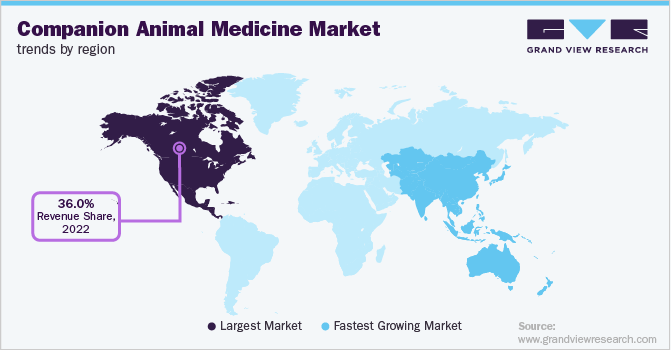
In Asia Pacific, the market is anticipated to witness the fastest CAGR of about 10.4% during the forecast period. The factors attributable to this growth include the growing pet population, the presence of local players, and an increasing number of vet clinics and hospitals. In addition, the region is home to the production facilities of many major animal health companies, such as Elanco, which further boosts the growth of the segment.
Key Companies & Market Share Insights
The market is intensely competitive in nature with the presence of many small and large companies. Market players are involved in deploying several strategic initiatives such as R&D, collaborations, product launches, product diversification, expansion of distribution network, and regional expansion. Key players are also involved in mergers and acquisitions and other sales and marketing activities. In August 2021, Elanco for instance acquired Kindred Biosciences for approximately USD 444 million. This supported the company’s access to the dermatology market, complemented its product pipeline, and enhanced R&D capabilities in biologics and monoclonal antibodies. Some prominent players in the global companion animal medicine market include:
-
Merck & Co., Inc.
-
Ceva
-
Vetoquinol S.A.
-
Zoetis
-
Boehringer Ingelheim International GmbH
-
Elanco
-
Virbac
-
Bimeda, Inc.
-
Norbrook
-
Calier
Companion Animal Medicine Market Report Scope
Report Attribute
Details
Market size value in 2023
USD 21.33 billion
Revenue forecast in 2030
USD 41.18 billion
Growth Rate
CAGR of 9.9% from 2023 to 2030
Base year for estimation
2022
Actual estimates/Historical data
2018 - 2021
Forecast period
2023 - 2030
Quantitative units
Revenue in USD Million & CAGR from 2023 to 2030
Report coverage
Revenue forecast, company share, competitive landscape, growth factors, and trends
Segments covered
Animal Type, region
Regional Scope
North America; Europe; Asia Pacific; Latin America; Middle East & Africa
Country Scope
U.S.; Canada; UK; Germany; France; Italy; Spain; Russia; Rest of Europe; Japan; China; India; Rest of APAC; Brazil; Mexico; Argentina; Rest of LATAM; South Africa; Saudi Arabia; Rest of MEA
Key companies profiled
Merck & Co., Inc.; Ceva; Vetoquinol S.A.; Zoetis; Boehringer Ingelheim International GmbH; Elanco; Virbac; Bimeda, Inc.; Norbrook; Calier
Customization scope
Free report customization (equivalent up to 8 analysts’ working days) with purchase. Addition or alteration to country, regional & segment scope.
Pricing and purchase options
Avail customized purchase options to meet your exact research needs. Explore purchase options
Global Companion Animal Medicine Market Segmentation
This report forecasts revenue growth at global, regional & country levels and provides an analysis of the latest industry trends in each of the sub-segments from 2018 to 2030. For this study, Grand View Research has segmented the global companion animal medicine market report based on animal type and region:

-
Animal Type Outlook (Revenue, USD Million, 2018 - 2030)
-
Dogs
-
By Product
-
Biologics
-
Vaccines
-
By Type
-
Attenuated Live Vaccines
-
Inactivated Vaccines
-
Recombinant Vaccines
-
Toxoid
-
Others
-
-
By Indication
-
Distemper
-
Kennel cough (Parainfluenza)
-
Parvovirus
-
Canine herpes
-
Lyme Disease
-
Rabies
-
-
-
Others
-
-
Pharmaceuticals
-
Parasiticides
-
Anti-infectives
-
Anti-inflammatory
-
Analgesics
-
Others
-
-
Medicated Feed Additives
-
-
By Indication
-
Infectious Diseases
-
Dermatologic Diseases
-
Pain
-
Orthopedic Diseases
-
Behavioral Diseases
-
Other Indications
-
-
By Distribution Channel
-
Retail
-
E-commerce
-
Hospital Pharmacy
-
-
-
Cats
-
By Product
-
Biologics
-
Vaccines
-
By Type
-
Attenuated Live Vaccines
-
Inactivated Vaccines
-
Recombinant Vaccines
-
Toxoid
-
Others
-
-
By Indication
-
Rhinotracheitis
-
Calicivirus
-
Coronavirus
-
Panleukopenia
-
Rabies
-
-
-
Others
-
-
Pharmaceuticals
-
Parasiticides
-
Anti-infectives
-
Anti-inflammatory
-
Analgesics
-
Others
-
-
Medicated Feed Additives
-
-
By Indication
-
Infectious Diseases
-
Dermatologic Diseases
-
Pain
-
Orthopedic Diseases
-
Behavioral Diseases
-
Other Indications
-
-
By Distribution Channel
-
Retail
-
E-commerce
-
Hospital Pharmacy
-
-
-
Horses
-
By Product
-
Biologics
-
Vaccines
-
Attenuated Live Vaccines
-
Inactivated Vaccines
-
Recombinant Vaccines
-
Toxoid
-
Others
-
-
Others
-
-
Pharmaceuticals
-
Parasiticides
-
Anti-infectives
-
Anti-inflammatory
-
Analgesics
-
Others
-
-
Medicated Feed Additives
-
-
By Indication
-
Infectious Diseases
-
Dermatologic Diseases
-
Pain
-
Orthopedic Diseases
-
Behavioral Diseases
-
Other Indications
-
-
By Distribution Channel
-
Retail
-
E-commerce
-
Hospital Pharmacy
-
-
-
Other Companion Animals
-
By Product
-
Biologics
-
Vaccines
-
Attenuated Live Vaccines
-
Inactivated Vaccines
-
Recombinant Vaccines
-
Toxoid
-
Others
-
-
Others
-
-
Pharmaceuticals
-
Parasiticides
-
Anti-infectives
-
Anti-inflammatory
-
Analgesics
-
Others
-
-
Medicated Feed Additives
-
-
By Indication
-
Infectious Diseases
-
Dermatologic Diseases
-
Pain
-
Orthopedic Diseases
-
Behavioral Diseases
-
Other Indications
-
-
By Distribution Channel
-
Retail
-
E-commerce
-
Hospital Pharmacy
-
-
-
-
Regional Outlook (Revenue, USD Million; 2018 - 2030)
-
North America
-
U.S.
-
Canada
-
-
Europe
-
U.K.
-
Germany
-
France
-
Italy
-
Spain
-
Rest of Europe
-
-
Asia Pacific
-
Japan
-
China
-
India
-
Rest of APAC
-
-
Latin America
-
Brazil
-
Mexico
-
Argentina
-
Rest of LATAM
-
-
Middle East & Africa
-
South Africa
-
Saudi Arabia
-
Rest of MEA
-
-
Frequently Asked Questions About This Report
b. The global companion animal medicine market size was estimated at USD 19.5 billion in 2022 and is expected to reach USD 21.33 billion in 2023.
b. The global companion animal medicine market is expected to grow at a compound annual growth rate of 9.9% from 2023 to 2030 to reach USD 41.18 billion by 2030.
b. North America dominated the companion animal medicine market with a share of about 36% in 2022. This is attributable to initiatives by the government & private sector, the rising adoption of pet insurance, and the presence of key companies.
b. Some key players operating in the companion animal medicine market include Merck & Co., Inc.; Ceva; Vetoquinol S.A.; Zoetis; Boehringer Ingelheim International GmbH; Elanco; Virbac; Bimeda, Inc.; Norbrook; and Calier.
b. Key factors that are driving the companion animal medicine market growth include the increasing prevalence of diseases in pets, rising pet expenditure, humanization of pets, adoption of online channels for buying pet medicines, and initiatives by key companies.
Share this report with your colleague or friend.
![gvr icn]()
NEED A CUSTOM REPORT?
We can customize every report - free of charge - including purchasing stand-alone sections or country-level reports, as well as offer affordable discounts for start-ups & universities. Contact us now
![Certified Icon]()
We are GDPR and CCPA compliant! Your transaction & personal information is safe and secure. For more details, please read our privacy policy.
We are committed towards customer satisfaction, and quality service.
"The quality of research they have done for us has been excellent."
